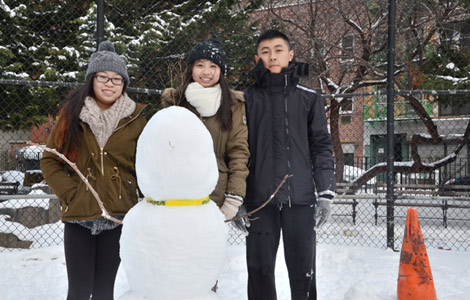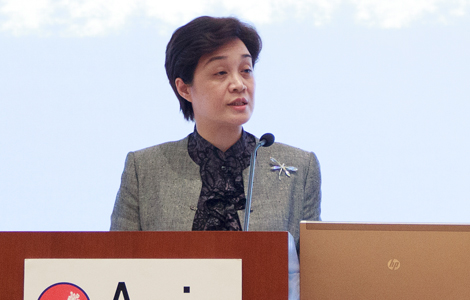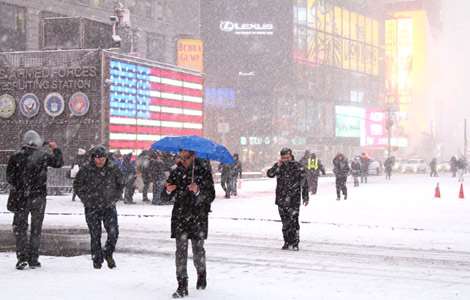What can be done to stem tide of teen suicide? Plenty
Updated: 2015-01-26 06:41
By Chang Jun(China Daily USA)
|
||||||||
For a mom with adolescent children like me, nothing could be sadder than seeing the loss of young lives, especially when those lives are taken away by teens themselves through suicide.
On Saturday, communities in the Bay Area grieved deeply as Palo Alto school officials confirmed that a male Gunn High School senior died by suicide near his residence in the early morning, this following two other fatal train killings in October and December of 2014.
As a community of affluent households and high-achieving schools, Palo Alto in recent years grabbed public attention because of a series of teen suicides. I can’t help but ask: What’s gone wrong?
Besides extending our deepest heartfelt sympathy to the families and friends of those affected, it’s important that we come together to support our youth, their families and their broader social circles.
We should also remember some basic information about suicide: its causes, how we can recognize those at risk and where to get help, suggested doctors Meg Durbin and Shashank Joshi on behalf of the executive committee of the HEARD Alliance, an organization comprised of professionals from Palo Alto Medical Foundation and Lucile Packard Children’s Hospital at Stanford, which aims at safeguarding teens’ mental health.
In an open letter to Gunn High parents on Saturday afternoon, superintendent Max McGee said the school's crisis response team would be meeting Saturday and Sunday and working with district and site staff, school board members and the district's community partners to coordinate support services for students and families throughout the district. Local mental-health organizations — Adolescent Counseling Services, nonprofit grief counseling Kara and Counseling Support Services for Youth — would provide extra support and assistance.
McGee urged parents to reach out to school principals, psychologists, counselors or district staff if they believe their child might be at risk. "Coming so closely to the deaths of other community youth in 2014, this event may make vulnerable youth especially at risk, so we want to remind you of the many resources in our community and share our plan to support our students as they return to school on Monday," McGee wrote.
"As we have mentioned before, please encourage your children to express their feelings to you and/or other trusted adults as well as give them space to reflect as needed," he wrote.
"As a father, I know how terribly complicated it is to work through tragic life events, and your unconditional love, non-judgmental listening and supportive presence go a long way in helping children heal in the wake of such trauma."
Although difficult, these conversations and time together more often than not will provide some comfort, even if it is not immediately apparent, said McGee.
May Lu, a Bay Area mom with kids in public school, agrees that quality parent-child time plays a very important role in helping teenagers adjust to new environments and reconcile conflicts with peers. Movie nights with her children and meaningful conversation on weekends are year-round rituals for Lu’s family. "I believe we enjoy each and every minute we spend together," said Lu.
Suicide is very complex and doesn't just happen to someone. Rather it tends to be preceded by a number of risk factors. There is usually a gradual progression from suicidal thinking to suicidal behavior to a suicide attempt. Some 75 to 90 percent of suicides occur in persons who have had mental illness or emotional health problems for at least a year, according to experts at the HEARD Alliance.
For parents and their friends, they need to know that suicidal youth may be more attracted to death and less able to generate alternatives to suicide when faced with severe stress. There are usually warning signs that we can all recognize to help those in need. Youth in transition — whether from high school to "what's next?" or when switching school settings — can experience unique stressors that our community must better understand. The 18-to-24-year-old age group can be particularly vulnerable in this regard, as the most recent suicides in Bay Area communities remind us, said HEARD Alliance experts.
United for a Better Community, a grassroots civic organization in the Bay Area, has teamed up with Santa Clara County to launch a youth program that trains young volunteers to answer stop-suicide hotlines in Mandarin.
"This project requires 80 hours of training before they are dispatched to a San Jose hospital to commit to at least 200 hours of answering the hotlines and helping their Mandarin-speaking peers who have suicidal thoughts," said Jia Xizhi, a supporter of UBC who also has an afterschool program.
Anyone who is feeling depressed, troubled or suicidal can call 1-800-784-2433 to speak with a crisis counselor. People in Santa Clara County can also call 1-855-278-4204.
Contact the writer at junechang@chinadailyusa.com

 Old photos of China's military parade
Old photos of China's military parade
 'Polar bear' roams in London, but don't panic
'Polar bear' roams in London, but don't panic
 The ancient practice of preserving and drying food
The ancient practice of preserving and drying food
 Seniors enjoy swimming despite the chill
Seniors enjoy swimming despite the chill
 Snow job
Snow job
 US, China expected to lead on climate talks
US, China expected to lead on climate talks
 Weighing in on justice in China
Weighing in on justice in China
 Northeastern US braces for 'crippling' blizzard
Northeastern US braces for 'crippling' blizzard
Most Viewed
Editor's Picks

|

|

|

|

|

|
Today's Top News
US, China expected to lead on climate talks
Weighing in on justice in China
China wants US to help build trust on maritime disputes
Yahoo to spin off Alibaba shares
China opens market to all US apples
Parade will commemorate victory over Fascism
Expatriates to be lured for startups
Beijing gears up for Super Bowl
US Weekly

|

|








